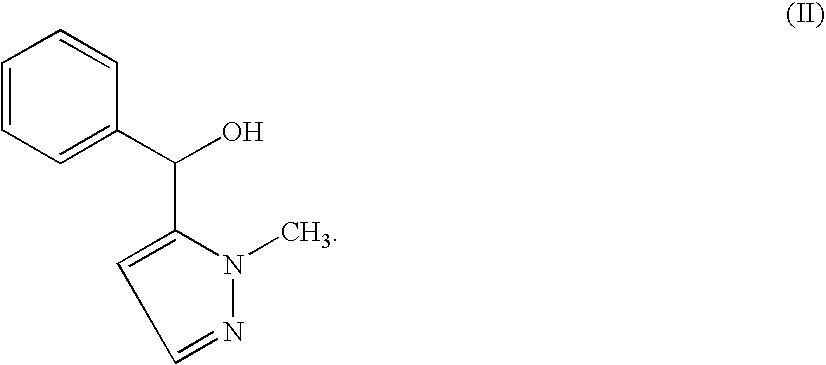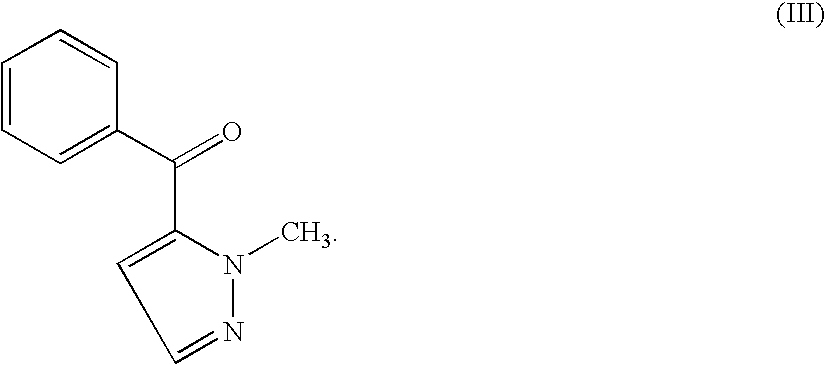Process for obtaining cizolirtine and its enantiomers
a technology of cizolirtine and enantiomers, applied in the field of process for obtaining cizolirtine and its enantiomers, can solve the problems of high catalyst loading, difficult to remove trace amounts of such metals, and difficult to reduce the corresponding ketone precursors, so as to avoid the presence of potentially toxic impurities, high conversion, and high enantiomeric purity
- Summary
- Abstract
- Description
- Claims
- Application Information
AI Technical Summary
Benefits of technology
Problems solved by technology
Method used
Image
Examples
example 1
Synthesis of 2-Methyl-2H-pyrazole-3-carbaldehyde
[0050] In a dry 50 ml vial is placed a solution of 1.642 g (20 mmol) N-methylpyrazole in 30 ml dry THF. The mixture is cooled to −20° C. and while stirring 8 ml (20 mmol, 2.5M in hexane) n-BuLi-solution is slowly added. The reaction mixture is stirred for 2.5 hours at −20° C. With vigorous stirring 4.7 ml (4.39 g, 60 mmol) dry DMF is slowly added at −20° C. and the mixture kept at this temperature for 1 hour. The reaction mixture then is poured into 100 ml of a 1 M acetic acid / sodium acetate buffer (pH 4.5), 50 ml MTBE is added and the organic layer is separated, washed with 50 ml saturated Na2CO3-solution to remove excess acetic acid (extraction with ethyl acetate leads to DMF in the final product). The organic layer is separated, dried with MgSO4 and the solvent is removed using a rotary evaporator. The crude product is purified by vacuum distillation (bp: 67° C., 21 mbar). Three preparations which were distilled together yielded 5....
example 2
Synthesis of (2-Methyl-2H-pyrazol-3-yl)-phenyl-methanol using triphenylborane ammonia complex
[0053] In a 20 ml vial is placed 8.91 mg (10 mol %) of (S)-2-piperidinyl-1,1,2-triphenyl-ethanol and 43 mg (0.17 mmol) of triphenylborane ammonia complex. The vial is closed and flushed with argon. Dry toluene (2 mL) is added and the vial is placed in a cooling bath of 10° C. Diethylzinc (0.7 mL, 15% in hexane) and 25 p1 (0.25 mmol) 2-methyl-2H-pyrazole-3-carbaldehyde is added and the reaction mixture is stirred for at least 12 hours at 10° C. The reaction is quenched by addition of 2 mL of 1 M HCl with vigorous stirring. The reaction mixture is placed in a separation funnel, 10 ml 1M HCl and approximately 25 mL MTBE is added. The organic layer is washed with 15 mL of saturated Na2CO3-solution, dried with MgSO4 and the solvent is removed by a rotary evaporator to yield 40 mg of the crude product. The product can be further purified by column chromatography on silica using ethyl acetate / hexa...
example 3
Synthesis of (2-Methyl-2H-pyrazol-3-yl)-phenyl-methanol using 2-aminoethyl diphenylborinate
[0061] In a 20 ml vial is placed 8.92 mg (10 mol %) of (S)-2-piperidinyl-1,1,2-triphenyl-ethanol and 56 mg of 2-aminoethyl diphenylborinate. The vial is closed and flushed with argon. Dry toluene (2 mL) is added and the vial is placed in a cooling bath of 10° C. Diethylzinc (0.7 mL, 15% in hexane) and 25 μl (0.25 mmol) 2-methyl-2H-pyrazole-3-carbaldehyde is added and the reaction mixture is stirred for at least 12 hours at 10° C. The work-up is conducted as described in Example 2 affording the product alcohol (R)-II (35 mg, 74%) in 89% ee.
PUM
| Property | Measurement | Unit |
|---|---|---|
| mol % | aaaaa | aaaaa |
| mol % | aaaaa | aaaaa |
| temperature | aaaaa | aaaaa |
Abstract
Description
Claims
Application Information
 Login to View More
Login to View More - R&D
- Intellectual Property
- Life Sciences
- Materials
- Tech Scout
- Unparalleled Data Quality
- Higher Quality Content
- 60% Fewer Hallucinations
Browse by: Latest US Patents, China's latest patents, Technical Efficacy Thesaurus, Application Domain, Technology Topic, Popular Technical Reports.
© 2025 PatSnap. All rights reserved.Legal|Privacy policy|Modern Slavery Act Transparency Statement|Sitemap|About US| Contact US: help@patsnap.com



